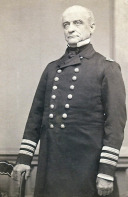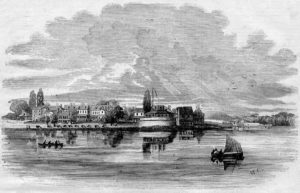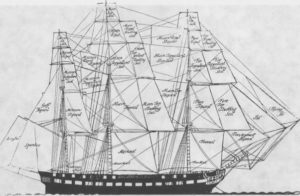 |
| George Smith Blake |
When the Civil War erupted in April 1861, Captain George S. Blake studied the position of the U.S. Naval Academy (USNA) in Annapolis, MD, and quickly realized that the school was indefensible should the rebels attack it.
According to a New York Times article “Early Days of the War,” published on January 13, 1897, USNA Superintendent Blake wrote to Secretary of the Navy Gideon Welles, pointing out the weaknesses of the school’s position. Maryland, wavering over secession, had a strong pro-South population; ripples of unrest throughout Maryland became quite strong after Fort Sumter had surrendered; rebel sympathizers in Annapolis began to proclaim publicly that the USS Constitution(then a training ship at the academy) should be the first ship of war to hoist the flag of the Confederacy; the only forces Blake had at command were his students, most of whom were little boys, and many of whom were citizens of the seceded states. To add to Blake’s problems, the telegraph office was operated by rebel-friendly hands, compromising Blake’s communications with Welles; everything sent by wire was reported to a local secession committee.
Blake proposed that should the USNA come under attack, he would render useless the guns onshore, destroy any ammunition that he couldn’t take with him, embark the students on the USS Constitution, and either defend the ship in the harbor or sail to Philadelphia or New York.
Welles responded shortly with a missive to “defend the Constitution at all hazards. If it cannot be done, destroy her.” The rebel navy was new and small, and such a prize as “Old Ironsides,” old but quite seaworthy, would be quite a feather in the Confederate Navy’s cap.
 |
| US Naval Academy, Annapolis, 1853 |
Blake received orders on April 27, 1861, to transfer the academy to Newport, RI. Immediately, the whole school set about to load “Old Ironsides” with the “library, instruments, philosophical apparatus, the naval trophies in the lyceum, and other property.” The students, instructors, and staff stowed their personal gear, and the old War of 1812 frigate sailed away. On May 8, 1861, the famous vessel cruised into Newport Harbor, RI, where she remained for the duration of the war. On May 13, Captain Blake reported the successful transfer of the school to Secretary Welles.
Early on during her Newport residence, “Old Ironsides” served not only as a training ship but as mess hall, classrooms, and housing for the students. As the war progressed, the Navy soon recognized that onshore housing and facilities were necessary, and Blake was instructed to organize this. Soon, various hotels were leased to serve as administrative offices, classrooms, and quarters for some of the students. Those students (upperclassmen) lucky enough to live onshore referred to their quarters as “Paradise” and those unlucky enough (underclassmen) to remain on board the school ships referred to their quarters as “Purgatory.”
John Pentangelo, in his Civil War Navy Sesquicentennial blog, offers a first-person account by Park Benjamin of the Class of 1867 of living conditions in Purgatory: “Nothing could be more desolate than the outlook to the ‘plebe’ whose first experience brought him to these school-ships. During the day he sat and studied at one of the desks, long rows of which extended up and down the gun-deck, and occasionally marched ashore to the windy recitation rooms, where he contracted bad colds along with knowledge of arithmetic. The commissary department was always more or less out of gear, and the meals eaten in the blackness of the berth-deck by the light of a few ill-smelling oil lamps were wretched.”
 |
| USS Constitution – sail plan |
One of the other school ships was The America, the first America’s Cup winner.
Although the USNA returned to Annapolis in August 1865, the Navy had spent enough time in Newport to realize the value of the place for maritime activity. The Navy subsequently located a torpedo-testing laboratory on Goat Island in the harbor, and built the Naval Training Station in Newport. The Naval War College was established there as well. For decades, Newport was a major port for Navy ships.
SOURCES
The Civil War Navy Sesquicentennial Blog – “Annapolis Comes to Newport,” by John Pentangelo, May 6, 2011 http://civilwarnavy150.blogspot.com/2011/05/annapolis-comes-to-newport.html
12 Meter Charters, Newport, RI http://www.12metercharters.com/newportsailing.asp
“Early Days of the War: Removal of Naval Academy from Annapolis,” New York Times, January 13, 1897.
United States Naval Academy: Naval Academy Band: History http://www.usna.edu/USNABand/history.htm
CNIC//Naval Station Newport: History http://www.cnic.navy.mil/Newport/About/History/index.htm
PHOTOS
George S. Blake: http://navy.togetherweserved.com/usn/servlet/tws.webapp.WebApp?cmd=ShadowBoxProfile&type=Person&ID=550497
US Naval Academy lithograph: “View of the Naval Academy,” New York Illustrated News, March 1853.
USS Constitution sail plan: Department of the Navy http://www.history.navy.mil/danfs/c13/constitution.htm



